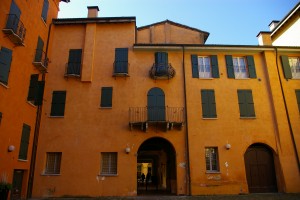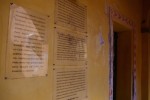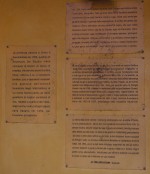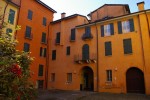Cento Jewish Community
The Jewish presence in Cento dates back to the end of the 14th century, but it is with the Estensi that it enjoyed its period of flourishing. From the 17th century began a progressive decline that led in the early 20th century to the merger with the Jewish community of Ferrara.
1.From the first settlements to the Este century
The beginning of the Jewish story in Cento dates back to 1390, the year of a notarial deed in which the Jew Manuel del Gaudio declared that he had received 120 lire from Bartolomeo Grazioli to repay a loan he had made to him. From this time until the 15th century, the Jewish presence in the city was constant and documented. The activities most practised by the members of the community are the lending of money and medicine, as evidenced by the fact that in 1467 the Jewish doctor Mosè Teutonicus was entrusted with the care of a Christian boy by virtue of the trust that his father placed in his professional skills.
In 1502, with the marriage between Lucrezia Borgia and Alfonso I d'Este, the Cento territory passed from papal control to that of Este and remained that way until 1598, when the entire duchy of Este became part of the Papal State. For the Jews, a period of development and flourishing began, also thanks to the arrival of Western Jews from Spain and Portugal, attracted by the Este house's reception policy.
2. Il ghetto
In 1624 Pope Urban VIII officially ordered the concentration of the Jews of the papal legation in the ghettos of Ferrara, Lugo and Cento, but it was only in 1636 that Bologna's papal legate Stefano Durazzo dictated the rules relating to the latter. The choice fell on a central area of the town, between Via Grande (now Via Marcello Provenzali) and the Borgo di Domani (now Via Olindo Malagodi), already inhabited by some families of Cento’s Jews. Some Christian owners had to transfer their homes to the manager of the Mandolino Simone Padoa Community for perpetual rent and the latter assigned the premises to the 13 heads of families, who were already residents or who had moved from other areas of the city.
Relations with the Christian population remained good, but during the 17th and 18th centuries the economic situation of the city, and therefore also of the Cento Jews, worsened especially due to the flooding of the Reno River. For many the only solution was emigration: an example is Beniamino D’Israeli, whose grandfather Isaac had arrived in Cento at the beginning of the 18th century from Venice. In 1748 Benjamin left Cento for England, where his son Isaac (1766-1848) left the London Sephardic community, changed his surname to Disraeli and had his four children baptised: his second son was Benjamin Disraeli (1804-1881), advisor and Prime Minister of Queen Victoria.
3. The 19th century
The gates of the ghetto were opened for the first time in 1796 with the arrival of French troops, but in 1825 they were restored at the expense of the 73 Jews then living in Cento. The forced concentration ended in the years between 1831 and 1833. There are reports of several hundred Jews participating in the Risorgimento movement: Giulio Levi participated in the expedition of the Thousand, Lazzaro Carpi was captain of the National Guard and at the Congress of Vienna in 1814 he incited European Jews to defend the newly conquered rights and took part in the riots of 1821, his son Leone Carpi (1810-1898) had contacts with Mazzini and took part in the work of the Roman Constituent Assembly and later became a deputy of Ferrara and the first Italian Parliament.
In the last decades of the 19th century a gradual decline began that in 1902 led to the decree of dissolution of the Community, since then merged with that of Ferrara.
4. World War II
After 1917 the only representatives of the Cento community are the three Finzi sisters, who as daughters of the last shamash (guardian) of the synagogue also became the custodians of the Cento Jewish places and properties. Due to racial laws, Amelia Finzi, who had taught in Cento for years, had her pension revoked, but there were no other harassing measures against them.
In the war years, the synagogue was twice devastated by the fascists, who took away all the ancient textile furnishings. In addition, with the establishment of a German command in the ghetto, part of the synagogue and books, manuscripts and documents kept in adjacent rooms were burned. What was saved was then transferred to Ferrara: the portal and the nineteenth-century benches of the synagogue, an aron (closet where the Torah scrolls are kept) and a wooden bimah (the tribune from which the Torah is read) perhaps coming from a private oratory and some objects of sacred art. The baroque aron of the public synagogue was taken to Israel in 1954 and is housed in a synagogue in Natanya.
In 1956, with the death of Bice Finzi, the Cento Jewish community ceased to exist.
5. The Long Night of 1943
Even in Cento, as in Ferrara, the night of 15 November 1943 was not a night like any other. The news of the arrival of the fascists from Verona, after the murder of Federale Ghisellini, caused dismay and fear. Bruno Alberghini, son of the housekeeper of the Finzi sisters, sensed the risk to objects stored in the ghetto, now guarded only by the elderly ladies. According to what his sister Adele told Tiziana Galuppi, Bruno decided to do something: helped by a saddler friend who had his shop in the ghetto, he climbed the stairs, entered the synagogue and began to store everything that was transportable in two bags of jute, including the Torah scrolls and their ornaments. Thanks to the elderly priest of the church of San Pietro, Don Galletti, those two sacks remained hidden under the high altar until the end of the war, when they were returned to the Jewish community of Ferrara.
Bibliography
Fototeca
Related places
Compiling entity
- Istituto di Storia Contemporanea di Ferrara
Author
- Federica Pezzoli
- Sharon Reichel




